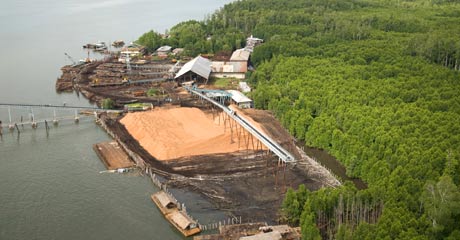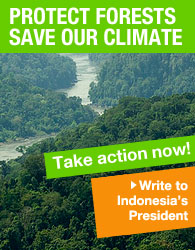
Without proper international funding, Indonesia's remaining forests are at risk of being consumed by oil palm plantations © Greenpeace/Sharomov
We’ve now crossed the administrative border between Papua and West Papua and, for the past couple of days, we’ve been anchored on the west side of Teluk Cenderawasih, a large bay which cuts into the Indonesian half of New Guinea, helping to create the distinctive ‘bird’s head’ feature. On the other side of the isthmus – the ‘bird’s neck’ – is Teluk Bituni and the largest mangrove area in south-east Asia.
It also features a mill making wood chips from the mangrove trees, and the Tweety team flew over this morning to confirm the mill was still in operation. Further along the bay, they also surveyed an existing oil palm plantation where, although it is still being farmed, it doesn’t look like there are currently any attempts to expand into the surrounding forest. That’s good news, but how do we make sure the forest remains intact? Even if a protected area was created to cover every square inch of forest, there is not enough money or resources to properly enforce that protection and make sure no one sneaks in to start up a logging operation.
The solution is to make the rich countries of the world help fund the protection of forests, not just in Indonesia but also in the Amazon and the Congo basin. It’s something Barnabas Suebu, governor of Papua, is attempting on Yapen Island which we flew over on Saturday, as well as in other parts of Papua.
There, a management plan is in operation which ensures the forest and its biodiversity are protected, and the people living on the island are working together with the local government. The traditional ownership rights of local people are recognised and documented by demarcating the boundaries of their land and to make sure they can still utilise the forest for their own needs, the community is involved at every level of the plan.

A woodchip mill in West Papua, Indonesia © Greenpeace/Sharomov
The plan needs more funding though, and the Papuan provincial government is looking to the international community to provide the cash. In return, the donor countries can count the emissions saved by preserving the forest in their own emission reduction figures.
This is similar to the funding plan we have proposed, called Forests For Climate, and we want to see it included in the next stage of the Kyoto Protocol currently being negotiated. The details are complex but the principle is simple: treat the protection of the world’s forests as an international concern, not just the problem of those countries which have forests.
And it wouldn’t cost that much. It’s estimated that halving emissions from deforestation would cost $10-15 billion a year which sounds a lot, but that’s peanuts compared to the $250 billion President Bush is today planning to pump into US banks to keep them afloat. The plan could also start protecting forests very quickly – as early as next year if there’s enough support.
The mechanism Greenpeace is proposing is fund-based rather than market-based – leave it to the free market, and we run the risk of governments trying to buy their way out of the climate crisis. It would result in a sort of large-scale carbon offsetting, where rich countries fiddled their books by purchasing credits for forest protection without doing anything to reduce their own emissions at home. A kind of carbon credit crunch, if you like.
And that’s a crucial point: as well as protection for indigenous rights and biodiversity, any funding mechanism has to operate together with deep emissions cuts through greater energy efficiency and generating clean, renewable energy.
Part of the purpose of our tour is to promote the Forests For Climate plan. When we reach Jakarta, we’ll be holding a meeting with the governors of Papua and Aceh provinces, Indonesian ministers and representatives from international governments to discuss it and get their support. And to make sure there’s still enough forest left to save, we still want the Indonesian government to call a moratorium on all deforestation while the details of how to permanently protect the forests are hammered out.
Read more about the Forests for Climate plan on our international website.
posted by Jamie on board the Esperanza




Leave a comment